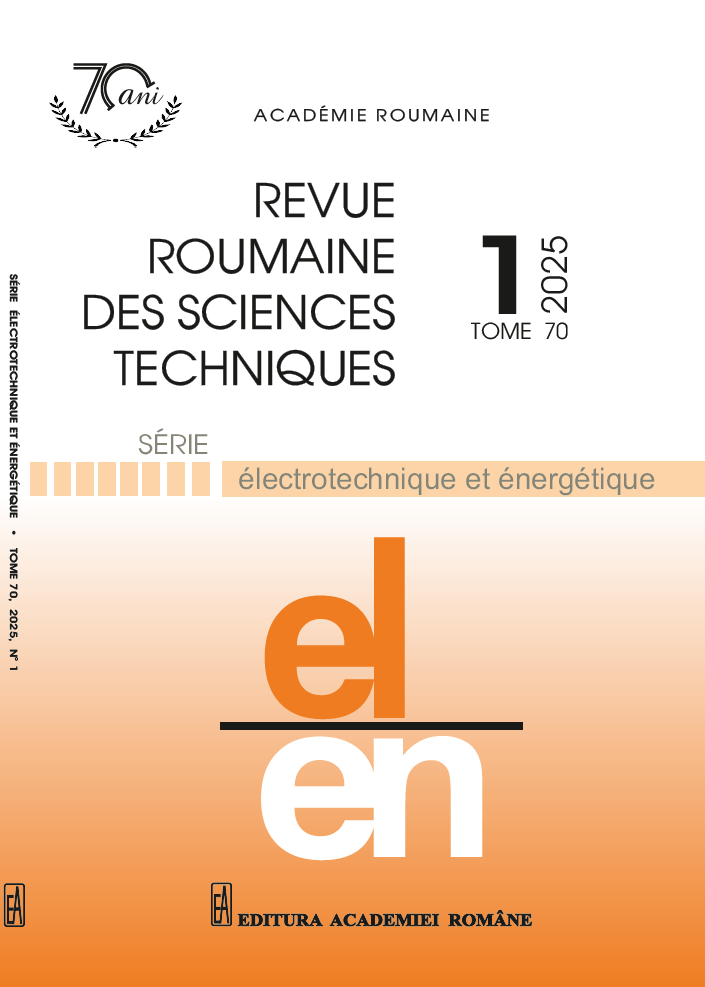UNE NOUVELLE CONCEPTION D'UN SYSTÈME PHOTOVOLTAÏQUE BASÉ SUR UN MOTEUR À INDUCTION LINÉAIRE ET UNE POMPE ALTERNATIVE
DOI :
https://doi.org/10.59277/RRST-EE.2025.1.1Mots-clés :
Photovoltaïque, Moteur à induction, linéaire, Pompe alternative, Contrôle orienté champ, Point de puissance maximaleRésumé
Cet article présente une nouvelle approche visant à améliorer l'efficacité et les performances des systèmes de pompage d'eau photovoltaïques (PV) en intégrant un moteur à induction linéaire (LIM) à une pompe alternative à double effet (DARP). Le système proposé est conçu pour obtenir un mouvement linéaire direct sans réducteur, réduisant ainsi les coûts et améliorant l'efficacité globale. Cette étude présente le circuit équivalent du LIM, y compris le phénomène d'effets terminaux, qui accroît sa complexité et complique son contrôle. Une technique de contrôle orienté champ (FOC) est proposée pour améliorer l'efficacité du moteur et les performances dynamiques afin de surmonter ce problème. De plus, le modèle des cellules PV dans des conditions environnementales telles que l'irradiance solaire et la température influence considérablement les caractéristiques I-V des panneaux PV. La méthode P&O basée sur MPPT a été mise en œuvre pour maximiser leur puissance de sortie. Les résultats de simulation, vérifiés et validés dans le logiciel Matlab/Simulink, démontrent que l'association de moteurs LIM et de pompes DARP offre des avantages par rapport aux pompes centrifuges à moteur rotatif traditionnelles. Cela confirme qu'il s'agit d'une solution avantageuse pour une irrigation économique, écologique et efficace.
Références
(1) H.K.V. Gadiraju, V.R. Barry, R.K. Jain, Improved performance of PV water pumping system using dynamic reconfiguration algorithm under partial shading conditions, CPSS Transactions on Power Electronics and Applications, 7, 2, pp. 206–215 (2022).
(2) L. Gevorkov, J.L. Domínguez-García, L.T. Romero. Review on solar photovoltaic-powered pumping systems, Energies, 16, 1, pp.94 (2023).
(3) R. Kahani, M. Jamil. M.T. Iqbal. An improved perturb and observed maximum power point tracking algorithm for photovoltaic power systems, Journal of Modern Power Systems and Clean Energy, 11, 4, pp. 1165–1175 (2023).
(4) H. Yeqing, N. Songlin, M. Kai, L. Fan, L. Lei, Static stress and modal analysis of water hydraulic reciprocating piston pump driven by the linear motor, International Conference on Fluid Power and Mechatronics (FPM), Harbin, China, pp. 914–917 (2015).
(5) R. Rajan, L.A.R. Krishna, S. Sreeja, Mathematical modelling and analysis of linear induction motor, IEEE International Power and Renewable Energy Conference (IPRECON), Kollam, India, pp. 1–6 (2022).
(6) A. Mousaei, M.B. Bannae Sharifian, N. Rostami, An improved predictive current control strategy of linear induction motor based on ultra-local model and extended state observer, 13th Power Electronics, Drive Systems and Technologies Conference (PEDSTC), Tehran, Iran, Islamic Republic of, pp. 12–18 (2022).
(7) P. Marcello, Direct field-oriented control of linear induction motors. Electric Power Systems Research, 89, pp. 11–22 (2021).
(8) M.R. Rezoug, R. Chenni, D. Taibi, Fuzzy logic-based perturb and observe algorithm with variable step of a reference voltage for solar permanent magnet synchronous motor drive system fed by direct-connected photovoltaic array, Energies, 11, 2, pp. 462 (2018).
(9) N. Kacimi, A. Idir, S. Grouni, MS. Boucherit, A new combined method for tracking the global maximum power point of photovoltaic systems, RRST-EE, 67, 3, pp. 349–54 (2022).
(10) S. Samah, M. Birane, K. Benmouiza, A comparative analysis of boost converter topologies for photovoltaic systems using MPPT (Po) and Beta methods under partial shading, RRST-EE, 68, 4, pp. 375–380 (2023).
(11) J. Duncan, Linear induction motor-equivalent-circuit model, IEE Proc. B, Electron. Power Appl., 130, 1, pp. 51–57 (1983).
(12) J.F. Gieras, G.E. Dawson, A.R. Eastham, A new longitudinal end effect factor for linear induction motor, IEEE Transactions on energy conversion, EC-2, 1, pp. 152–159 (1987).
(13) L. Khettache, R. Abdessemed, A new speed control approach of linear induction motor based on robust RST controller and model reference adaptive system estimator, International Journal of Engineering, 36, 4, pp. 630–639 (2023).
(14) L. Zhang, H. Obeid, S. Laghrouche, M. Cirrincione, Second order sliding mode observer of linear induction motor, IET Electric Power Applications, 13, 1, pp. 38–47 (2019).
(15) H.A. Hussain, H.A. Toliyat, A fault monitoring system for a reciprocating pump driven by a linear motor for oil pumping systems, IEEE Energy Conversion Congress and Exposition (ECCE), Cincinnati, OH, USA, pp. 4338–4344 (2017).
(16) K. Wang, Y. Li, Q. Ge, L. Shi, An improved indirect field-oriented control scheme for linear induction motor traction drives, IEEE-Transactions on Industrial Electronics, 65, 12, pp. 9928–9937 (2018).
(17) D.B. Jani, C. Chetan, J. Chauhan, Da. Baria, U. Barjod, J. Bangadiya, Performance investigation on double acting reciprocating pump, Applied Energy. 6, 4 pp. 14–17 (2019).
(18) G. Boyun, X. Liu, X. Tan, Transportation systems, Petroleum Production Engineering, Gulf Professional Publishing, pp. 275–325 (2017).
(19) C.F. Lieu, W.K. Chan, K.T. Ooi, Experimental investigation of the reciprocating ball pump (RBP), Medical Engineering & Physics, 34, pp. 1101– 1108 (2012).
(20) J. Pei, C. He, M. Lv, X. Huang, K. Shen, K. Bi, The valve motion characteristics of a reciprocating pump, Mech. Syst. Signal Process., 66–67, pp. 657–664 (2016).
(21) S. Pant, R.P. Saini, Solar water pumping system modelling and analysis using MATLAB/Simulink. IEEE Students Conference on Engineering & Systems (SCES), Prayagraj, India, pp. 1–6 (2020).
(22) 22. M. Errouha, S. Motahhir, Q. Combe, et al., Intelligent control of induction motor for photovoltaic water pumping system.SN Appl. Sci., 3, 777 (2021).
Téléchargements
Publiée
Numéro
Rubrique
Licence
(c) Copyright REVUE ROUMAINE DES SCIENCES TECHNIQUES — SÉRIE ÉLECTROTECHNIQUE ET ÉNERGÉTIQUE 2025

Ce travail est disponible sous licence Creative Commons Attribution - Pas d'Utilisation Commerciale - Pas de Modification 4.0 International.


